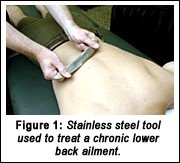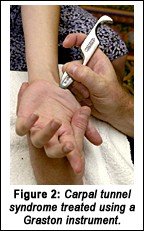After they offered to send a PT, PhD candidate from Indiana to demonstrate the instrument-assisted technique, I relented. I thought that if they were willing to go to that expense, I have nothing to lose (except for a few patients, of course). The Graston technique was demonstrated on a variety of conditions, including a chronic lower back problem (Figure 1), a chronic cervical spine, a lateral epicondylopathy and a plantar fascitis to name a few. What I discovered has prompted me to reconsider my position concerning the use of my hands alone. All of the patients improved by the next visit. I have used the instruments for three months, and am forced to admit that these instruments allow me to palpate and treat soft tissue that cannot be accurately felt with the human hand.
While a stainless steel instrument cannot compare with the human hand in palpation of skin temperature, moisture, tissue layers and movement, such as skin rolling, there are definite advantages of these instruments over manual assessment. When we palpate using the pads of our fingers we feel for the usual nodules, restrictive barriers and tissue tensions, among other things. What surprised me most was that with the instruments the tissue feeling was greatly magnified. The fat pads of our fingers compress tissues, while the instrument, with a narrower surface area at its edge, has the ability to separate fibers. In a broader sense, it's as if we are running our fingers over the strings of a harp, except that the strings are much closer together. The feeling of the individual fibers is transmitted as a vibrating sensation through the stainless steel to our hands. The practitioner and the patient are together able to detect the abnormal gritty, sand-like restrictive collagen cross-links. Our fingers cannot duplicate this sensation. Interestingly, a bystander or the patient can hold on to the instrument as it glides over the fibers and experience the same "grizzly" or "grayish" abnormal fiber sensation. The instrument can then be moved nearby as a comparison to experience normal tissue sensation.
Another important feature of these instruments is the ability to penetrate and feel the texture of tissue at deeper levels. For anyone in the soft tissue world who works on knees, plantar fascia and carpal tunnel areas, to mention a few, a tremendous benefit is the saving of our own joints, muscles and tendons. There is no longer stress on our own appendages, which will allow us to work much easier in our later years. Forty years of pressure on my hands is totally relieved with these instruments!
A major reason for soft tissue technique is to palpate and eliminate both superficial and deep restrictive tissue due to collagen interfiber cross-links and diminished glycoaminoglycans (GAGs). The loss of GAGs creates a tissue dehydration and hardening of the gel. It is essential in many chronic cases to be able to remove all of the "grizzle" for complete tissue freedom. I regret to say that our fingers cannot penetrate to feel all of it. During the last few months I had treated several patients with chronic lateral epicondylosis and carpal tunnel syndrome (Figure 2) who improved but didn't completely resolve. I called them to return for treatment to see if these instruments would make a difference.
Instrument palpation of the lateral epicondylosis picked up several fibrous areas just off the anterior border of the lateral epicondyle, and in the belly of the extensor carpi radialis brevis that I completely missed with my hands. This time I used the instruments to totally remove all of the "grizzle" I could find. I also treated and evaluated other areas of the kinetic chain such as the triceps, biceps, flexor and extensor forearm areas. There were plenty of restrictions to deal with, and the patient was amazed. Her symptoms were completely resolved! She regained the ability to function virtually pain free. Testing resistive wrist extension at least 10 times in a row, strong, passive wrist flexion was painless.
We must also understand that part of the resolution must deal with the rehabilitation of the tissues involved. In all cases, patients must be taught stretching and strengthening exercises so that tissue remodeling will continue to its normal termination. In the carpal tunnel patient (Figure 2) I found deep restrictions in the thenar, hypothenar, palm, forearm flexor and extensor areas that, when removed, completely resolved the problem.
I was so convinced at the efficacy of the instruments that New Jersey DC Gregory Doerr and I demonstrated the Graston technique on about 150 DCs at the recent Florida State convention. Admittedly, I am now a consultant for its developer, based upon what I have learned. One of the tests we performed was to ask them to palpate their own thenar eminence with their hands, then palpate it with the instrument. In nearly every case, the DCs remarked that they felt much more fiber restriction with the instrument than with their hands.
Good news for the friction massage practitioners is that with this technique you only should spend up to one minute on a local area. For the deep fascial areas, after treatment you can repalpate the tissue with the instrument and feel a significant difference. Restricted areas versus normal areas invariably turn red in a short time, due to the immediate breakdown of blood vessels, which are more fragile in abnormal adhesion-type tissue. The same theory of creating a new inflammatory cascade (fibroblastic proliferation) to promote a new healing, as discussed in past articles, still holds true. I still use my hands directly on patients, especially for superficial fascial areas throughout the body, and on the subscapularis belly and iliopsoas.
The ability to palpate, penetrate and treat deep fascial fibrotic adhesions by the use of this type of instrumentation immediately supplants the many fascial release techniques in use today. The following represents a few of the many case studies, positive outcome studies and research that lends support to this method.1-5
References
- Graston D, Hall A. Graston Technique Manual, 2nd ed., 1997. TherapyCare Resources, Inc.
- TherapyCare Resources Clinic Outcomes (as of 12-98): Poster presentation: APTA combined sections meeting, Seattle, WA., Feb. 1999.
- Davidson CJ, Ganion LR, Gehlsen GM, et al. Rat tendon morphologic and functional changes resulting from soft tissue mobilization. Medicine & Science in Sports & Exercise, 1997:313-319.
- Sevier TL, Gehlsen GM, Wilson JK, et al. Traditional physical therapy vs. Graston augmented soft tissue mobilization in treatment of lateralepicondylitis. JACSM 27(5), 1995.
- Sevier TL, Wilson JK, Melham TJ, et al. A comparison of augmented softtissue mobilization vs traditional physical therapy for carpal tunnel syndrome. CTD News, Oct. 1997.
Warren Hammer,MS,DC,DABCO
Norwalk, Connecticut
Click here for previous articles by Warren Hammer, MS, DC, DABCO.







